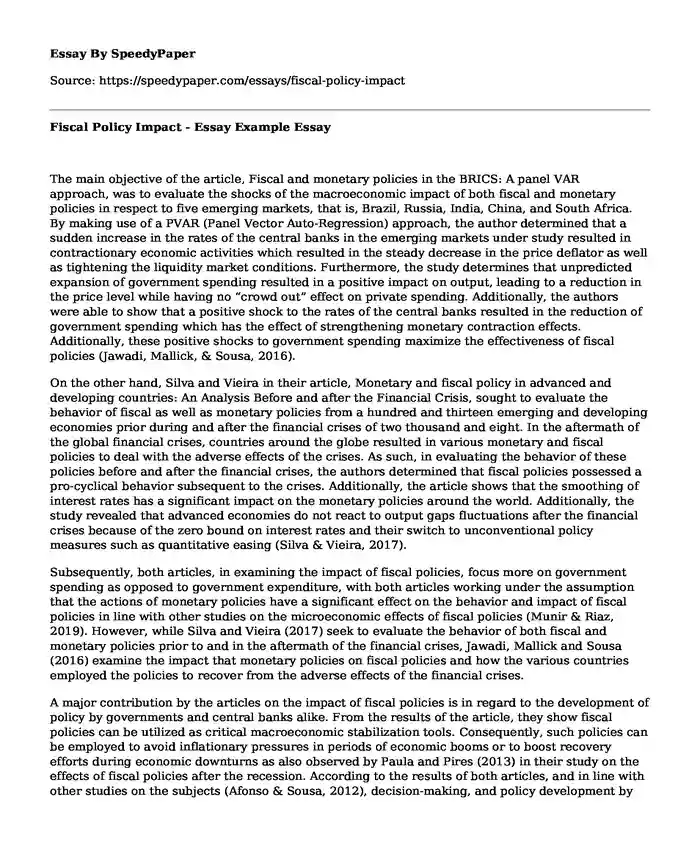
| Type of paper: | Essay |
| Categories: | Finance Macroeconomics Policy analysis |
| Pages: | 3 |
| Wordcount: | 742 words |
The main objective of the article, Fiscal and monetary policies in the BRICS: A panel VAR approach, was to evaluate the shocks of the macroeconomic impact of both fiscal and monetary policies in respect to five emerging markets, that is, Brazil, Russia, India, China, and South Africa. By making use of a PVAR (Panel Vector Auto-Regression) approach, the author determined that a sudden increase in the rates of the central banks in the emerging markets under study resulted in contractionary economic activities which resulted in the steady decrease in the price deflator as well as tightening the liquidity market conditions. Furthermore, the study determines that unpredicted expansion of government spending resulted in a positive impact on output, leading to a reduction in the price level while having no “crowd out” effect on private spending. Additionally, the authors were able to show that a positive shock to the rates of the central banks resulted in the reduction of government spending which has the effect of strengthening monetary contraction effects. Additionally, these positive shocks to government spending maximize the effectiveness of fiscal policies (Jawadi, Mallick, & Sousa, 2016).
On the other hand, Silva and Vieira in their article, Monetary and fiscal policy in advanced and developing countries: An Analysis Before and after the Financial Crisis, sought to evaluate the behavior of fiscal as well as monetary policies from a hundred and thirteen emerging and developing economies prior during and after the financial crises of two thousand and eight. In the aftermath of the global financial crises, countries around the globe resulted in various monetary and fiscal policies to deal with the adverse effects of the crises. As such, in evaluating the behavior of these policies before and after the financial crises, the authors determined that fiscal policies possessed a pro-cyclical behavior subsequent to the crises. Additionally, the article shows that the smoothing of interest rates has a significant impact on the monetary policies around the world. Additionally, the study revealed that advanced economies do not react to output gaps fluctuations after the financial crises because of the zero bound on interest rates and their switch to unconventional policy measures such as quantitative easing (Silva & Vieira, 2017).
Subsequently, both articles, in examining the impact of fiscal policies, focus more on government spending as opposed to government expenditure, with both articles working under the assumption that the actions of monetary policies have a significant effect on the behavior and impact of fiscal policies in line with other studies on the microeconomic effects of fiscal policies (Munir & Riaz, 2019). However, while Silva and Vieira (2017) seek to evaluate the behavior of both fiscal and monetary policies prior to and in the aftermath of the financial crises, Jawadi, Mallick and Sousa (2016) examine the impact that monetary policies on fiscal policies and how the various countries employed the policies to recover from the adverse effects of the financial crises.
A major contribution by the articles on the impact of fiscal policies is in regard to the development of policy by governments and central banks alike. From the results of the article, they show fiscal policies can be utilized as critical macroeconomic stabilization tools. Consequently, such policies can be employed to avoid inflationary pressures in periods of economic booms or to boost recovery efforts during economic downturns as also observed by Paula and Pires (2013) in their study on the effects of fiscal policies after the recession. According to the results of both articles, and in line with other studies on the subjects (Afonso & Sousa, 2012), decision-making, and policy development by governments across the world can reap benefits from leveraging the aspects that shape the relationship between monetary and fiscal policies.
References
Afonso, A., & Sousa, R. M. (2012). The macroeconomic effects of fiscal policy. Applied Economics, 44(34), 4439-4454. https://doi.org/10.1080/00036846.2011.591732
Jawadi, F., Mallick, S. K., & Sousa, R. M. (2016). Fiscal and monetary policies in the BRICS: A panel VAR approach. Economic Modelling , 58, 535-542. http://dx.doi.org/10.1016/j.econmod.2015.06.001
Munir, K., & Riaz, N. (2019). Macroeconomic effects of fiscal policy in Pakistan: a disaggregate analysis. Applied Economics , 51(52), 5652-5662. https://doi.org/10.1080/00036846.2019.1616074
Paula, L. F., & Pires, M. C. (2013). The effects of fiscal policy after the global recession: assessing the evidences. Brazilian Journal of Political Economy , 33(2), 315-321. https://doi.org/10.1590/S0101-31572013000200007
Silva, C. G., & Vieira, F. V. (2017). Monetary and fiscal policy in advanced and developing countries: An analysis before and after the financial crisis. The Quarterly Review of Economics and Finance , 63, 13-20. http://dx.doi.org/10.1016/j.qref.2016.04.013
Cite this page
Fiscal Policy Impact - Essay Example. (2023, Aug 27). Retrieved from https://speedypaper.com/essays/fiscal-policy-impact
Request Removal
If you are the original author of this essay and no longer wish to have it published on the SpeedyPaper website, please click below to request its removal:
- Essay Sample on The World Bank Group Research
- Essay Example: Unemployment as a Social Issue Affecting the Quality of Life in Jamaica
- Free Essay on the Control of Drug Pricing in the US by Medicare
- Free Essay Sample on The United States and International Law
- Essay Sample on Importance of Business Sustainability
- Essay Sample on Effects of Globalization on Sovereignty and Inequality
- Essay Sample on Supply and Demand in American Auto Industry
Popular categories




